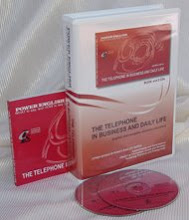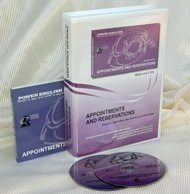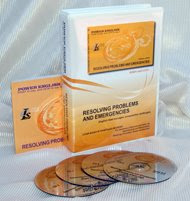What do a concert piano and a voice mail greeting have in common?
Both need regular fine-tuning.
On the answering machine at home
I usually leave a short outgoing message.
“You’ve reached the number for Natasha Cooper.
Sorry, I missed your call. Please leave a message.”
Or even shorter:
“This is Natasha Cooper. Please leave a message.”
At work I regularly update my voice mail greeting to let callers know
what’s a good time to catch me in, or when to expect a callback.
“This is Natasha Cooper. It is Monday, December 6th.
I’ll be away from my desk until 2 p.m.
If you would like to leave a message,
please do so after the tone.”
If I am going to be absent longer than a day,
I leave the number of a colleague or my secretary.
“I’ll be out of the office until Thursday the eleventh.
Please leave a message after the tone or call Linda Ferguson, extension 521.”
Leaving on a trip, I change the outgoing message again.
“I’m traveling until June 17th. My voice mail is unable
to keep messages for more than a week.
Please call back and leave your message after June 10th.”
To friends who sometimes have a hard time understanding phone messages,
I recommend the use of a voice mail greeting like this:
“This is [your first and last name].
Help me get your message right.
Please speak slowly and clearly, spell your name,
and repeat your number twice. Thank you.”
Let’s hope that callers will pay attention.
© 2009 Natasha Cooper
Would you like to use this article? You may as long as you include the following information along with it: Natasha Cooper, author of Power English System, helps international professionals to succeed by learning powerful communication skills. If you want to improve your English, then you’ll want to get Natasha’s F-R-E-E weekly Power English Minute E-zine by visiting www.englishskills.com.
src="http://pagead2.googlesyndication.com/pagead/show_ads.js">
Wednesday, March 25, 2009
Sunday, March 22, 2009
Taking Messages
Click on the PLAY button for sound.
When it comes to taking messages,
I follow the “Three GET’s” Rule:
get the message, get it right, then get it to the right person!
"He’s not available right now,"
I say, answering a colleague’s phone. Right away I offer:
“I’d be glad to take a message for him.’
"Tell him Jim called," says the caller.
Jim who?
"May I have your last name, please?"
"Matuschechek." Better safe than sorry.
Why don’t I ask him to spell it?
"Could you spell that?"
And it doesn’t hurt to double-check.
"Let me read that back to you.
M - A - T - U - S - C - H - E - C - H - E - K."
Now I need to find out what company he is with.
"And who are you with, Jim?"
And his phone number.
"At what number can he reach you?"
Then I double-check to avoid mistakes.
"That’s 222 - 555 - 0000..."
I don’t recognize the area code, so I ask:
"What city is that in?"
Could that be in a different time zone?
"What time is it there?"
Now - the message.
"And what’s the message?"
And a convenient time to call him back.
"When’s the best time to call you?"
That should be all.
"Thank you. I’ll make sure he gets the message."
Okay, what’s next? …
Oh yes, get it to the right person!
© 2009 Natasha Cooper
Would you like to use this article? You may as long as you include the following information along with it: Natasha Cooper, author of Power English System, helps international professionals to succeed by learning powerful communication skills. If you want to improve your English, then you’ll want to get Natasha’s F-R-E-E weekly Power English Minute E-zine by visiting www.englishskills.com.
src="http://pagead2.googlesyndication.com/pagead/show_ads.js">
When it comes to taking messages,
I follow the “Three GET’s” Rule:
get the message, get it right, then get it to the right person!
"He’s not available right now,"
I say, answering a colleague’s phone. Right away I offer:
“I’d be glad to take a message for him.’
"Tell him Jim called," says the caller.
Jim who?
"May I have your last name, please?"
"Matuschechek." Better safe than sorry.
Why don’t I ask him to spell it?
"Could you spell that?"
And it doesn’t hurt to double-check.
"Let me read that back to you.
M - A - T - U - S - C - H - E - C - H - E - K."
Now I need to find out what company he is with.
"And who are you with, Jim?"
And his phone number.
"At what number can he reach you?"
Then I double-check to avoid mistakes.
"That’s 222 - 555 - 0000..."
I don’t recognize the area code, so I ask:
"What city is that in?"
Could that be in a different time zone?
"What time is it there?"
Now - the message.
"And what’s the message?"
And a convenient time to call him back.
"When’s the best time to call you?"
That should be all.
"Thank you. I’ll make sure he gets the message."
Okay, what’s next? …
Oh yes, get it to the right person!
© 2009 Natasha Cooper
Would you like to use this article? You may as long as you include the following information along with it: Natasha Cooper, author of Power English System, helps international professionals to succeed by learning powerful communication skills. If you want to improve your English, then you’ll want to get Natasha’s F-R-E-E weekly Power English Minute E-zine by visiting www.englishskills.com.
src="http://pagead2.googlesyndication.com/pagead/show_ads.js">
Subscribe to:
Posts (Atom)





